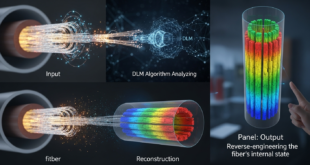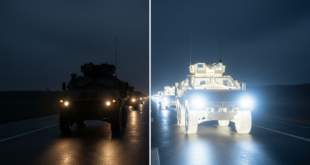UK Strategic Command is expected to invest £1.5 billion in the next ten years to “build and sustain a ‘digital backbone’ to share and exploit vast amounts of data, through the cloud and secure networks”, according to Defence Secretary Ben Wallace MP. Embedded military systems are the foundation of this data-driven approach to defence. These systems are vital in collecting, analyzing and communicating data from the battlefield or outposts. This means they must meet rigorous regulatory standards, be physically ruggedised to endure harsh environmental conditions and support rapid, reliable and secure data communication.
Many of the newer defence applications that have arisen from advanced technologies, such as increased video processing to improve situational awareness, require a distributed military computing approach that combines networking with hardware-accelerated computing via field-programmable gate array (FPGA) devices.
The future networked soldier will carry many systems interconnected through internet. These include end-user device (EUD) that combines helmet-mounted heads-up display, ruggedized keyboard, computer, navigation devices, GPS, and associated batteries and cables. A man-packable radio to send and receive information and voice data. Communications systems that convert between RF and IP, including terrestrial radio, satellite communications, and Wi-Fi. A soldier may become an ad-hoc Wi-Fi node in a mesh network. A system power source and support equipment. Regardless of the hardware used, wired Ethernet is the key component that ties everything together. Every ounce and inch on a soldier is critical to their survivability. Tying Ethernet components together with a minimum of weight and minimal power requirements is essential.
An increasing number of UAVs are employing modular elements and systems connected via Ethernet. The next-generation Global Hawk UAV, for example, will use an all modular set of elements connected through fiber optics and using IPv6. IPv6 will allow data to be directly forwarded to its destination without reformatting. While payloads may differ for each application, all these systems have common elements which must interconnect for flawless operation in the absence of a human operator. Each device must communicate with a centralized compute platform and trafc is often consolidated and transmitted via satellite back to a command station.
Ethernet is family of networking technologies initially developed for wired LAN networks implementation. Since its introduction almost 40 years ago, Ethernet was several times claimed as an obsolete technology that should be replaced with (at that time) new emerging technologies, for example Token Ring, FDDI, Emulated LAN. Anyway, Ethernet has not only survived, but also it was significantly developed and several new implementations were introduced so that today Ethernet is the most widely spread wired networking technology. Ethernet dominance is based on low cost, easy to configure and deploy equipment. Ethernet offers a range of benefits, including higher bandwidth, scalability, speed, and low latency.
Ethernet is a network protocol that controls how data is transmitted over a LAN. Ethernet is networking technology that covers first two layers of OSI reference model.
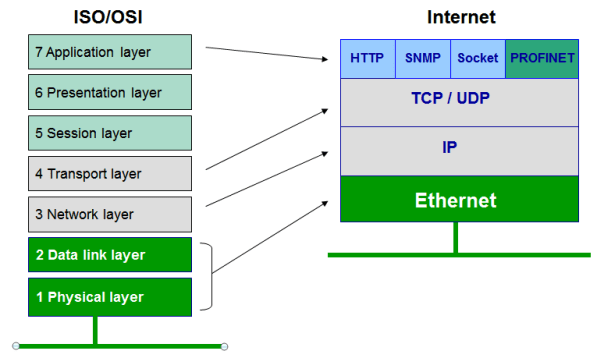
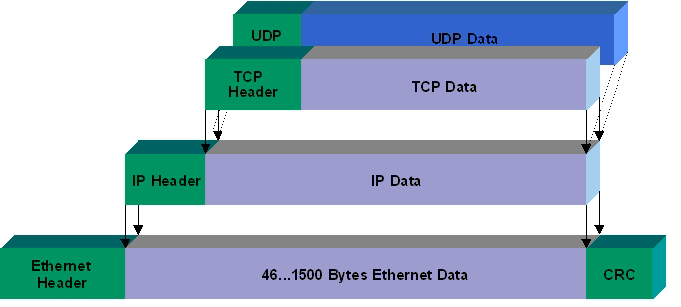
Ethernet was built with the assumption that all computers on a network use a shared communication channel. To handle the shared use of a single channel, Ethernet uses the carrier sense multiple access with collision detection (CSMA/CD) protocol to govern who is allowed to send traffic, and when. Carrier sensing is combined with collision detection to improve the performance of network traffic by halting any in-flight data transmission if a collision happens. With collision detection, if a node sending data detects a collision, the node stops transmitting the current frame, then waits for a random amount of time before trying to resend the packet.
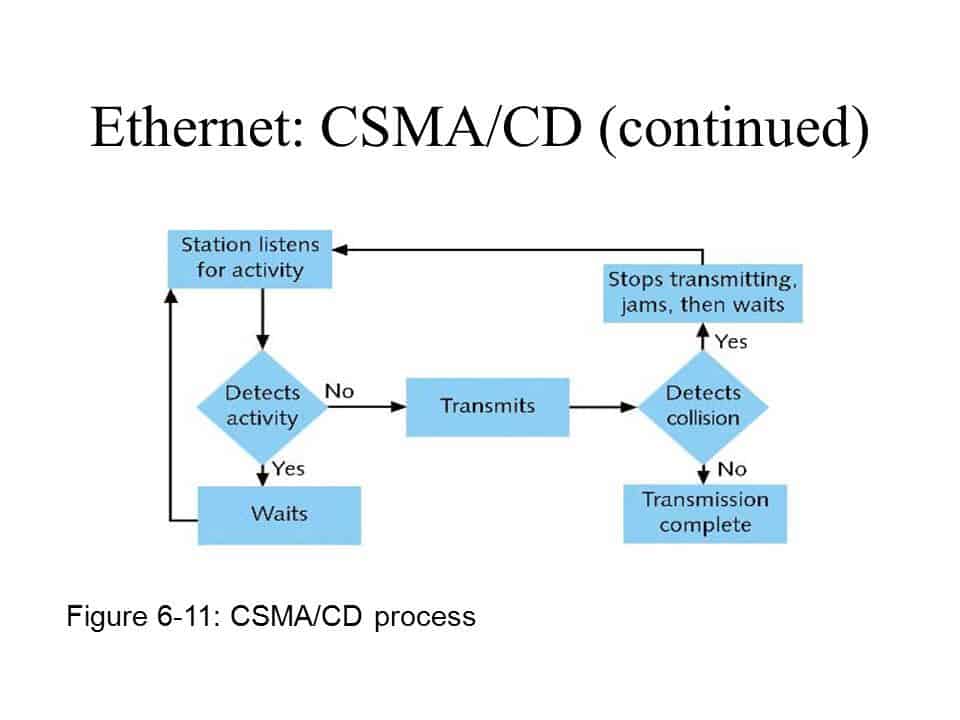
Ethernet Switches
In a modern Ethernet network, computers do not typically use the same communication channel. Rather, each computer has a private cable that is connected to the network through an Ethernet switch. In this topology, the only communication channel for a node is between the node and the switch, meaning that collisions are only possible if a node and the switch attempt to communicate with each other at the same time. In addition, the full duplex Ethernet standards completely separate the send and receive channels so that they can run simultaneously. Combining full duplex standards with a switching topology means modern Ethernet networks can be completely collision free.

A network switch (also called switching hub, bridging hub, and, by the IEEE, MAC bridge) is networking hardware that connects devices on a computer network by using packet switching to receive and forward data to the destination device. Switches for Ethernet are the most common form of network switch. Switches also exist for other types of networks including Fibre Channel, Asynchronous Transfer Mode, and InfiniBand. Unlike less advanced repeater hubs, which broadcast the same data out of each of its ports and lets the devices determine which data is addressed to them, a network switch forwards data only to the devices to which it is addressed
According to research firm Gartner, there is expected to be somewhere in the region of 25 billion Internet of Things (IoT) devices globally by 2021. Most of the devices won’t be domestic smart lighting or security systems, however. The majority will be used for field-level performance and diagnostic data processing and sharing across private networks of critical industrial systems or sharing of image data between security and military devices.
Ethernet is also enbling the Industrial Internet of Things (IIoT) or simply as industrial networking, there is no doubt that connected field systems are becoming increasingly valuable across industries. One of the main components underpinning this connectivity is the Ethernet switch. Once exclusively used in IT environments, these switches now find themselves commonly used in harsh rail, marine, industrial and military environments.
Far from being confined to IT environments, Ethernet switches are now present in demanding industrial environments across the globe. As the IIoT and network connectivity extends to more industries and applications, Ethernet switches continue to perform a crucial role for years to come. Although often overlooked, their importance cannot be understated — and nor can the importance of making the right choice.
In environments such as these, the speed, security and availability of network communication is imperative. As such, managed Ethernet switches are a staple of modern industrial network architectures, able to promptly relay data between connected devices and wider networks in a way that can be physically and virtually secured.
In the rail industry, Ethernet switches serve several purposes. They may be required to transfer data from networked sensors, cameras or accelerometers onboard the train itself, or they may be required to handle trackside data transmission. Another common use is for onboard Ethernet switches to provide internet connectivity to passengers.
In both cases, high data speed and efficiency is beneficial, and the switch itself must be ruggedized to withstand the operating environment. Although Recab UK has extensive experience in developing bespoke railway grade Ethernet switches, one of our go-to off-the-shelf managed Ethernet switches for rolling stock applications is the NL30 series by duagon-MEN.
Military embedded systems are often tasked with data-intense processes, such as capturing and processing data from images and video feeds on a military vehicle. This data is processed in the field but is then required to be transmitted back to a command center. This must be done quickly, efficiently and securely to ensure that a swift decision and response can be coordinated. Because security is of the utmost importance, military and defense Ethernet switches should include native features to maximize protection of network data. These include features such as port-level authentication, mirroring to support traffic monitoring and mixed media or fiberoptic ports to protect against electromagnetic (EM) snooping.
The switches themselves are also required to be ruggedized, with a wide operating temperature suitability and high shock resistance. Ruggedization of switches to meet military standards requires consideration of design aspects such as PCB thickness, latching connectors and enclosures, all while considering the size, weight and power (SWaP). An ideal switch that meets these strict criteria is Aitech’s A661 rugged small form factor Ethernet switch. The A661 comprises two 24-port Ethernet switch boards in a rugged enclosure, allowing for 48 ports each with 10/100/1000 Mbps data rates. It can perform layer two and three routing and switching functionality, features port monitoring for non-invasive switch traffic monitoring and includes 802.1X authentication for port-level security.
The robust enclosure of the switch provides ingress protection and has an EM interference (EMI) and radio-frequency interference (RFI) protected design, to protect network data from external intrusion. In fact, the A661 has successfully passed space radiation tests and has been installed on the International Space Station. The system’s power and input/output connections are ruggedized MIL-STL-38999 connectors to ensure regulatory compliance and ensure lasting performance.
In addition to the A661, Aitech has also developed the A664 standalone managed Ethernet switch/router, which is SWaP-optimized to make it an ideal option for military networks where size or weight is limited. Much like the A661, this switch is fully ruggedized to withstand the harsh military environments, but while also including four multimode optical fiber ports that support fiber communications for distances up to 550 metros in applications where copper cabling is unsuitable. The A664 is also readily able to meet another critical requirement for military networks: resiliency. The switch supports improved network resiliency by featuring Spanning Tree (xSTP) and virtual router redundancy (VRRP) protocols.
Increasingly, offshore and marine applications are embracing connectivity as a way of reducing maintenance costs for remote systems or to use unmanned vehicles with lidar or sonar to produce topographic maps of subsea environments. These are just two examples but, in both cases, data needs to be communicated to a network of devices so that engineers can make use of it.
Ethernet switches in marine environments must be adequately ingress protected to IP67 or higher, as well as be able to operate effectively under the low temperatures for prolonged periods of time. In terms of network functionality, the Ethernet switch should ideally be able to support high numbers of data paths if it is intended to handle data from sonar or radar systems.
VX6940 6U VPX Ethernet switch from Kontron as an option for VPX platform applications. This is a layer two and three switch designed for long-term applications. It features two front QSFP28 transceivers, which support up to 100G speed optical or passive copper connections, and each allowing for four 10GB or SFP+ ports. Kontron’s VX6940 switches are best suited to data intensive applications that require many data paths, such as naval sonar or radar systems, when coupled with Kontron ARM or X86 computing nodes.
Next generation Ethernet
The market for Ethernet is growing again, even for new technologies such as 5G access points, in driver-assisted/autonomous vehicles, and within connected industrial operations. Automotive Ethernet provides connectivity for various automotive applications such as powertrain, chassis, body and comfort, ADAS, and infotainment systems. With Ethernet, you can get away from the CAN (controller area network) bus and LIN (local interconnect network) bus, which makes moving data more efficient. It also adds reliability and security, because these older networks are where a lot of hacks are coming in through. It supports high bandwidth applications operating at high or low speed. Moreover, it also reduces cable and labor cost by simplifying the network complexities that includes configuration, management, and optimization aligned with in-vehicle networks. Increase in demand for ADAS and infotainment systems have propelled automotive Original Equipment Manufacturers (OEMs) to adopt Ethernet hardware components.
Ethernet is the well-established standard in government, enterprise, and home applications. Ethernet is playing part in Smart cities that are both connected and sustainable. The goal of the smart city, is to make the most of lighting, heating and cooling, and provide increased security through deployment of poe remote cameras in public spaces. Ethernet is also helping bring innovation to the datacenter. Engineers are turning to this power and data solution for a whole host of purposes. These range from linking servers, network virtualization, virtual machine migration, video on demand, the IoT. New, higher Ethernet data rates will also enter the market to meet the needs of new video-intensive applications available over cloud networks. To match data rates such as 100 Gb / s, 200 Gb / s and 400 Gb / s, technologists are developing new materials and new architectures that will allow these speeds to overcome what was impossible in the past
Ethernet speeds are running anywhere from 10 megabits per second (Mbps) to 400 gigabits per second (Gbps). The growth in bandwidth for network aggregation applications was found to be outpacing the capabilities of networks employing link aggregation with 10 Gigabit Ethernet. Most high-speed Internet home services are currently maxing out at about 60 Mbps for copper-based services, while Fiber services are now offering “near gigabit Ethernet” speeds. The 400 Gigabit Ethernet standard is set to be ratified this year. Gigabit protocol in the industrial ethernet market is projected to witness an extensive adoption for facilitating connections between various devices such as robots, sensors, PLCs, and other industrial machines. The Gigabit Ethernet predominantly employs optical fiber connection for the transmission of information over long distances with high speeds. It is expected to witness a large-scale adoption between 2019 and 2025. The technology is mostly deployed to increase the data transfer rate between server & client farms and to connect with fast Ethernet switches.
Distributed military computing requires provide low-latency, high availability, interoperability between networked devices and high bandwidth to be effective. The challenge has traditionally arisen from the wide use of Ethernet for networking. It is rapidly becoming the standard for military and other rugged applications due to proven interoperability, reliability, and speed. Historically, dedicated bus architectures have been used in military applications, resulting in heavy and somewhat inexible systems. Ethernet has been shown as a viable alternative for a number of reasons including ubiqitousness, interoperability, wide availability of components. The modularity and availability of small, interoperable components has opened up new applications, including the future digital soldier, unmanned autonomous vehicles (UAVs), along with land, air and sea platforms.
Standard Ethernet functions by sending data packets in a way that is largely dependent on network loads, which is not suitable for networked devices that need high degrees of synchronization. Although cheap and ubiquitous, it is generally non-deterministic in nature — beneficial for reliability, but less than ideal for mission critical systems that require real-time data transmission.
New standards are arising, such as IEC 62439-3 and TSN Time-Sensitive Networking- (a set of standards under development by the Time-Sensitive Networking task group of the IEEE 802.1 working group), which are helping to meet mission-critical network demands. These standards, alongside development in this technological space, are driving innovation in military networks.
One such company at the forefront of this is System-on-Chip engineering (SoC-e), an expert in FPGA-based Ethernet solutions that Recab UK works closely alongside to offer high availability systems for defence Ethernet networks. SoC-e is also an active participant in many leading industry and academic groups that are developing and governing the standards for deterministic Ethernet. These groups have been active in the defining and development of new Ethernet-based protocols such as High-availability Seamless Redundancy (HSR), Parallel Redundancy Protocol (PRP) and Time-Sensitive Networking (TSN).
Power over Ethernet (PoE) performance, as the new PoE options are documented and marketed for a wide range of new applications and systems – from smart buildings to home appliances and the Internet of things, sensors and controls. Another area of rapid introduction of new Ethernet technology is applications that provide the ability to connect our homes and enterprises to the core network through the development of the next generation Passive Optical Network (PON) technology, which will provide aggregate speeds of 50 Gb / s over networks, reaching at least 50 km.
IEEE Standards
In 2006, the IEEE 802.3 working group formed the Higher Speed Study Group (HSSG) and found that the Ethernet ecosystem needed something faster than 10 Gigabit Ethernet. HSSG determined that two new rates were needed: 40 gigabit per second for server and computing applications and 100 gigabit per second for network aggregation applications. The IEEE 802.3ba 40 Gbit/s and 100 Gbit/s Ethernet amendment to the IEEE 802.3-2008 Ethernet standard was approved on June 17, 2010 by the IEEE Standards Association Standards Board.
The IEEE 802.3az standard was approved on September 30, 2010. It is the first standard in the history of Ethernet to address proactive reduction in energy consumption for networked devices and it is designed to provide network managers and networking services consumers with the tools to reduce energy consumption in network-attached devices, network routers and switches, computers, and printers.
With the launch of three new study groups, the IEEE 802.3 Ethernet Working Group continues to drive the ongoing adoption of Ethernet across a broad range of industries and is helping improve the performance and reliability of the technology for end users through standards development aims to develop a new standards project for multi-gigabit automotive applications that can provide network bandwidth, robustness and data security needed for such things as making fully autonomous vehicles a reality. The scope of the PTP Timestamping Accuracy Study Group is to develop a new standards project for improving Precision Time Protocol (PTP) timestamping accuracy on Ethernet interfaces. The newly formed study group will explore technology advancement on network packet timestamping, including investigation into various events that potentially affect network performance, in order to provide network operators with the capability for improved time and frequency communication.
IEEE 802.3 10SPE Multidrop Enhancements Study Group looks to build on the imminent IEEE P802.3cg standard by extending the reach of the multidrop segment, adding a multidrop power option, and adding optional support for Time Synchronization Service Interface (TSSI) to enable PTP. The scope of the Study Group is to develop a new standards project for 10 Mb/s Single Pair Ethernet Multidrop Enhancements. Read more. Single Pair Ethernet (SPE) is a key technology to enable the transition to Ethernet taking place in the building and industrial automation industries.
The chair of the New Industry Applications IEEE-SA IC project, John D’Ambrosia, is currently collaborating on the 802.3cg standards. This meeting-of-the-minds will address the need for a clear and focused roadmap for the near-term future. With so many technologies leveraging Ethernet and benefitting from recent improvements, additional considerations are necessary. The following are among the key goals of the 802.3cg collaboration: Assess emerging requirements for the development of Ethernet standards, Identify gaps not currently addressed by IEEE 802.3 standards, Facilitate building industry consensus towards proposals to initiate new standards development efforts
Single Pair Ethernet
The 10 Mbit / s Ethernet (10SPE) single-pair network was approved by IEEE in November 2019, adding two new physical layer specifications to support data and power per 1000 m copper cable with one twisted pair cable, as well as multi-channel connection with 8 nodes per 25 m cable . These attributes make it uniquely suited to enable Ethernet within buildings and industrial automation networks. The Advanced Physical Layer (APL) project is based on 10SPE for use in hazardous areas.
HSR
HSR is one of two protocols standardised in IEC 62439-3, alongside PRP. The key difference between these two protocols is that HSR focusses on providing seamless redundancy in time-constrained networks, while PRP is capable of providing seamless redundancy via two independent standard Ethernet networks. PRP introduces redundancy to the nodes.
HSR nodes can be arranged in a ring topology (only ring topology), with HSR providing redundancy by sending packets in both directions. A simple HSR network consists of doubly attached bridging nodes, each having two Ethernet ports. Both ports send the same data frame so that, in a fault-free scenario, nodes receive two identical frames. This means that even if connection is broken, there is no frame loss and communication continues among all network nodes. However, the requirement of a ring topology can be limiting in the implementation of HSR in military edge computing. Similarly, HSR requires that all nodes either process or pass along all data packets, which can increase processing requirements and add to network latency.
PRP
The PRP protocol works by creating parallel paths in redundant networks for duplicate data packets to pass through. Dual attached nodes (DANs) are connected to two independent and standard local Ethernet networks (LAN A and LAN B), with identical frames sent over both networks. The PRP operative ensures the receipt of all the information, even if one network fails. Non-PRP nodes can ignore the frames, reducing processing requirements, and the PRP protocol is compatible with standard Ethernet hardware.
TSN
The technology that seems to be the most promising from a military perspective is TSN, which sits at the data link layer (layer two) in the open systems interconnection (OSI) model. TSN is defined by the IEEE 802 group of standards and provides determinism to enforce advanced quality-of-service policies, while also supporting the merging of real-time, reserved and best-effort traffic in the same network. TSN is also unique in that its streams are delivered with guaranteed bandwidth and deterministic latency.
There are several IEEE standards under development that outline specific features of TSN, including synchronisation (802.1AS), scheduled traffic (802.1Qbv), reserved traffic (802.1Qav), seamless redundancy (802.1CB), and frame pre-emption (802.1Qbu and 802.3br). Although not all standards are required to support TSN, networks and switches that can meet these standards offer a clear advantage in military environments. The selection of sub-standards above are among some of the most relevant for military networking.
The synchronisation standard (802.1AS) is, of course, imperative and arguably the most important in a military and defence context. Based on the IEEE 1588-2008 standard precise time protocol (PTP), the synchronisation in TSN allows devices in the network to share the same time reference within a nanosecond time range. This means its possible for Ethernet networks to provide a level of synchronisation that is comparable to GPS. The high availability on TSN can be achieved by adding frame replication and elimination as defined in IEEE 802.1CB. In a similar way as defined for HSR, the frames include a sequence number and are replicated, with each copy sent through a different path in the network.
To achieve the lowest possible latency in engineered networks, the Time Aware Shaper functionality is introduced in the IEEE 802.1Qbv traffic scheduling standard. This works with applications where time-critical data is sent at regular periodic intervals and it is based on adding time gates on each queue on a port. This is complemented by the pre-emption supported by IEEE 802.1Qbu and 802.3br. A higher priority frame can interrupt the lower priority frame transmission, reducing the latency of time-sensitive streams.
Deterministic military Ethernet
Realising these new Ethernet technologies in defence applications requires the use of a system that provides the flexibility to support the right protocol for a given application. To this end, Recab has partnered with SoC-e, whose Relyum range offers an ideal all-in-one solution, to support military and defence original equipment manufacturers (OEMs) in the UK and Northern Europe. Products in this range are tested and certified to military standards including MIL-STD-810G & MIL-STD-461G.
Relyum by SoC-e is a range of military commercial off-the-shelf (COTS) managed 1/10G ethernet switch, router and edge computing equipment. The RELY-MIL-SWITCH-ROUTER platform supports up to 20x 1G copper and up to 6x 1/10G fibreoptic ports, with support for different media types and its distribution in the MIL-DTL-38999 connectors allowing for complete and cost-effective network infrastructures.
The product specifically boasts a Xilinx Ultrascale+ MPSoC device that includes six ARM CPUs, one GPU and a FPGA in the same integrated circuit. The switching and routing functions are accelerated by hardware in the FPGA section, which gives it the flexibility to meet various military requirements. This flexibility allows the Relyum to support HSR/PRP or TSN protocols with the same hardware. Fibreoptic rings combining these protocols are feasible thanks to the inter-switch coordination mechanism developed by SoC-e. Additionally, Relyum equipment support a wide set of security functionalities, in order achieve the strictest requirements in those kinds of applications.
The flexibility makes it an ideal option for numerous military applications, whether on land, in air or at sea. For example, military land vehicles benefit from zero-delay recovery time, deterministic Ethernet communication, and can also take advantage of the equipment to embed hardware-software microservices oriented to sensor data pre-processing. The RELY-MIL-SWITCH-ROUTER is also Generic Vehicle Architecture (GVA) compliant, making it an ideal fit for defence vehicles.
It’s innovations such as these that are driving a data-driven approach to military and defence, by connecting frontline devices and supporting the reliable, secure transmission of mission-critical data. Although overshadowed somewhat by armoured vehicles and drones in the UK Defence and Security Industrial Strategy, embedded military computing and networking are the true digital backbone of modern defence operations. Continued development and investment in this area will help the armed forces to continue crossing new technological frontiers in the years and decades to come.
Market growth
The industrial ethernet market is predicted to hike from USD 25 billion in 2018 to around USD 70 billion by 2025, according to a 2019 Global Market Insights, Inc. report. The rapidly growing adoption of Industrial IoT (IIoT) predominantly among the manufacturing and automotive sectors to improve the efficiency of production processes and supply chain is driving the growth of the market. Supportive government initiatives and hefty investments to extensively convert traditional grids into smart grids are resulting in the proliferation of the market.
Large-scale adoption of industrial Ethernet products, such as switches, gateways, connectors, processors, and controllers for structuring industrial networks, is expected to boost the market growth over the forecast timeline. The advent of innovative technologies, such as big data analytics, coupled with the increasing demand for cloud-based solutions in several enterprises across various sectors is escalating the demand for data centers, resulting in the industrial ethernet market growth.
The service segment is projected to exhibit the fastest growth in the industrial ethernet market between 2019 and 2025, reporting a CAGR of over 20% owing to the need for effective installation, testing, and maintenance of the network infrastructure to ensure long-term stability. The software solution segment is estimated to grow at a significant CAGR over the forecast timeline owing to its capability to enable network management through the monitoring of industrial Ethernet networks with a varying number of nodes.
The automotive & transport segment is expected to witness an accelerated growth in the industrial ethernet market throughout the forecast timeline owing to the increasing requirement of bandwidth in automobiles. The automobiles are currently transforming from hardware-driven machines to software-driven electric devices, resulting in a significant increase in complexity and weight of wiring harness. Consequently, OEMs are integrating more computer-based systems, connections, and applications to ensure proper connectivity between systems, contributing to an exponential increase in wiring harness, resulting in the third highest heaviest and costliest component in cars. It can significantly reduce the complexity and the cost of wiring in the automotive by providing a single network for connecting all the systems via a central switch.
Asia Pacific is growing at the highest CAGR in the industrial ethernet market due to the rapid growth of manufacturing automation applications in the region supported by Industry 4.0. The supportive government initiatives & policies for driving the adoption of industrial automation among the manufacturing and automotive industries are also estimated to have a significant impact on market growth over the forecast timeline.
The players operating in the industrial ethernet market are aggressively focusing on developing sophisticated Ethernet switches for harsh environmental applications. Some of the key players operating in the market are, ABB Ltd., Advanced Motion Control, ACS Motion Control Ltd., Alta Industrial Motion, Beckhoff Automation, B&R Automation, Belden, Inc. (Hirschmann), Cisco Systems, Inc., Bosch Rexroth AG, Honeywell International, Inc., Eaton Corporation, Moxa, Inc., Innovasic, Inc., Omron Corporation, Schneider Electric SE, Rockwell Automation, Parker Hannifin Corporation, Yaskawa Electric Corporation, Siemens AG, and Yokogawa Electric Corporation.
HARTING Americas announces launch of breakthrough Single Pair Ethernet technology
Harting Americas announced their North American launch of their Single Pair Ethernet technologies. The company has been driving the creation of a Single Pair Ethernet standard for the Industrial marketplace since 2015 along with other industrial companies and global standards bodies, such as IEC and IEEE.
Single Pair Ethernet communicates across the common industrial Ethernet protocols available today (Ethernet/IP, Profinet, EtherCAT, etc.) but instead of using 4 or 8 total wires, it accomplishes communication across just two wires, a single twisted pair. Also, it is utilizing Power over Data Line (PoDL) technology to not only bring communication to the device but also the voltage and amperage needed to power the device itself. This is hugely beneficial for three reasons.
First, space and number of connections are reduced on the device. Second, the need for an external power supply is eliminated. Finally, devices on the plant floor that have traditionally communicated over Fieldbus protocols can now join the same IP-based network that the rest of the devices on the network are using. This enables peer-to-peer communication, open-loop feedback of all devices, and smart functionality all the way from the main control room down to the individual device.
References and Resources also include:
https://www.itproportal.com/features/the-growing-importance-of-ethernet-switches-in-industry/
 International Defense Security & Technology Your trusted Source for News, Research and Analysis
International Defense Security & Technology Your trusted Source for News, Research and Analysis
